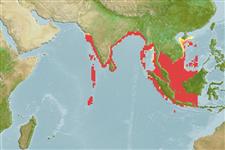>
Scombriformes (Mackerels) >
Scombridae (Mackerels, tunas, bonitos) > Scombrinae
Etymology: Scomberomorus: Latin, scomber = mackerel + Greek, moros = silly, stupid (Ref. 45335).
More on author: Cuvier.
Environment: milieu / climate zone / depth range / distribution range
นิเวศวิทยา
เกี่ยวกับทะเล,น้ำเค็ม; สัตว์น้ำที่อาศัยและอพยพภายในทะเลเท่านั้น (Ref. 51243). Tropical; 24°N - 11°S, 70°E - 115°E (Ref. 168)
Indo-West Pacific: west coast of India and Sri Lanka eastward to Thailand, Malaysia and Java (Ref. 9684). Does not extend further out in the East Indies (Ref. 9684).
Length at first maturity / ขนาด / น้ำหนัก / Age
Maturity: Lm 70.0 range ? - ? cm
Max length : 94.0 cm FL เพศผู้/กระเทย; (Ref. 168); 98.0 cm (female); common length : 70.0 cm FL เพศผู้/กระเทย; (Ref. 9684)
เงี่ยงครีบหลัง (รวม): 15 - 18; ก้านครีบอ่อนที่หาง (รวม): 15-19; ก้านครีบอ่อนที่ก้น: 17 - 22; สัตว์มีกระดูกสันหลัง: 44 - 46. A unique pigment pattern of short lines on the sides which distinguishes from all other species of Scomberomorus; maxilla with the posterior end greatly expanded; parasphenoid wide (Ref. 10996). Interpelvic process small and bifid. Lateral line without auxiliary branches anteriorly, running almost straight below second dorsal finlet then slightly bent downward toward keel of caudal peduncle. Intestine with 2 folds and 3 limbs. Swim bladder absent. Body covered with small scales. First dorsal fin black posteriorly.
Unlike S. commerson and S. guttatus, S. lineolatus is not encountered in very turbid waters or much reduced salinity. Feeds primarily on fishes. Also taken with midwater trawls, purse seines and by trolling (Ref. 9684). Taken from Oct.-Nov. along the Thai coast, Indian Ocean; in Malaysia Nov.-Feb. in the west coast, Mar.-Jul. in the south, Feb.-Mar. and Aug.-Nov. in the east; in India from May-Sept. with other seerfishes. Marketed mainly fresh; also dried-salted (Ref. 9684). Also consumed as spicy fishballs.
Collette, B.B. and C.E. Nauen, 1983. FAO Species Catalogue. Vol. 2. Scombrids of the world. An annotated and illustrated catalogue of tunas, mackerels, bonitos and related species known to date. Rome: FAO. FAO Fish. Synop. 125(2):137 p. (Ref. 168)
IUCN Red List Status (Ref. 130435)
Threat to humans
Harmless
Human uses
การประมง: การค้า; การตกปลาเป็นกีฬา: ใช่
ข้อมูลเพิ่มเติม
อ้างอิงการเพาะเลี้ยงสัตว์น้ำประวัติการเพาะเลี้ยงสัตว์น้ำสายพันธุ์พันธุศาสตร์ElectrophoresesอัตราพันธุกรรมโรคการแปรรูปNutrientsMass conversion
ผู้ร่วมมือรูปภาพหลายรูปStamps, Coins Misc.เสียงปลามีพิษ เช่น ปลาปักเป้าความเร็วรูปแบบการว่ายน้ำพื้นที่เหงือกOtolithsสมองวิสัยทัศน์
เครื่องมือ
Special reports
Download XML
แหล่งที่มาจากอินเตอร์เน็ต
Estimates based on models
Preferred temperature (Ref.
123201): 23.8 - 28.6, mean 27.7 °C (based on 595 cells).
Phylogenetic diversity index (Ref.
82804): PD
50 = 0.5000 [Uniqueness, from 0.5 = low to 2.0 = high].
Bayesian length-weight: a=0.00692 (0.00371 - 0.01290), b=2.99 (2.83 - 3.15), in cm total length, based on LWR estimates for this species & Genus-body shape (Ref.
93245).
ระดับชั้นอาหาร (Ref.
69278): 4.5 ±0.80 se; based on food items.
ความสามารถในการกลับคืนสู่ปกติ (Ref.
120179): ขนาดกลาง, เวลาต่ำสุดที่จะทำให้ประชากรเพิ่มขึ้นเป็น 2 เท่าใช้เวลา 1.4 - 4.4 ปี (K=0.18-0.22; tm=2; Fec=560,000).
Fishing Vulnerability (Ref.
59153): Very high vulnerability (82 of 100).
Climate Vulnerability (Ref.
125649): Very high vulnerability (82 of 100).
Nutrients (Ref.
124155): Calcium = 31.6 [14.0, 106.5] mg/100g; Iron = 0.806 [0.360, 1.933] mg/100g; Protein = 20.6 [19.3, 21.8] %; Omega3 = 0.267 [0.165, 0.431] g/100g; Selenium = 58.3 [21.7, 190.0] μg/100g; VitaminA = 25.5 [6.3, 113.2] μg/100g; Zinc = 0.659 [0.434, 1.038] mg/100g (wet weight);
